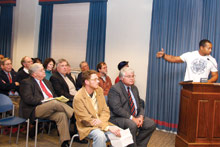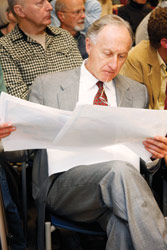In a tense 3-2 vote at their Jan. 6 meeting, the Buncombe County Board of Commissioners endorsed alternative 3, a controversial route for the Interstate 26 connector through Asheville.

Vice Chair Bill Stanley and Commissioners Carol Peterson and K. Ray Bailey supported alternative 3, while board Chair David Gantt and Commissioner Holly Jones opposed it.
“When I went out into the community and talked to people about this, the people I mixed and mingled with all through the county—all of those people said to me either 2 or 3 would be the better position because of cost and time, because of getting from point A to point B,” said Bailey.
Jones, on the other hand, said she’d heard very few people outside of the Asheville Area Chamber of Commerce who favored alternative 3, noting, “It’s not scientific, but I’ve received 199 e-mails for 4b and one for 3.”
Ramping up the emotional heat is the fact that alternative 3 (also backed by the Asheville Area Chamber of Commerce) would displace the most homes of any of the four remaining alternatives: 61 all told, including 24 in the predominantly African-American Burton Street neighborhood. Most of the other homes are in an Emma trailer park.
The vote came after a nearly two-hour-long public-comment session, with county residents packing the boardroom and spilling out far into the hall. The vast majority of nearly 30 people who spoke supported alternative 4b, developed by the nonprofit Asheville Design Center. The locally produced plan calls for separating local and interstate traffic while minimizing the amount of land required to build the road. Many speakers vehemently opposed alternative 3, including Burton Street residents who said it would destroy their neighborhood.
Vivian Conley, whose neighbors will lose their homes if alternative 3 is built, had harsh words for the route’s supporters on the board.
“I wish we could impeach them,” she told Xpress after the vote. “Who is [Bailey] talking to? CEOs? CEOs don’t pay for anything. We’re the working people—we’re the taxpayers—and this is what they want to do to us? It’s appalling.”
Both Peterson and Stanley said they’re concerned about the Burton Street neighborhood, and Bailey amended Peterson’s motion to endorse alternative 3, encouraging the state Department of Transportation to look for ways to minimize the impact there.
“DOT’s going to do what they want to do—whichever one we vote for, they’re going to pick the one they like,” said Stanley. “But I’m going to fight for the residents of Burton Street. I’m going to vote for 3 to get it cracking, but I’m going to combat them over the Burton Street folks.”

Jones, however, wasn’t buying it. “I do think part of our role is to tell the truth: The truth is 4b exists because that’s the fight for Burton Street,” she said. “You can’t fix [alternative] 3 and help Burton Street. I can understand there’s choices, but that’s why we have these alternatives—because people, among other things, wrenched at the idea of this community being torn apart. I feel it’s important for people to know that to vote for 3 and pretend that alternative won’t hurt Burton Street is just not real.”
Angered, Stanley shot back. “Ms. Jones, are you implying I lied when I said I’d fight for Burton Street?”
Jones said she wasn’t.
“Sounds like that’s what you’re saying,” countered Stanley.
“I’m just saying those two don’t go,” Jones replied.
“None of them will go,” asserted Stanley. “DOT’s not going to build it: 4b won’t fly. There’s 70,000 plus people in the city; there’s over 200,000 plus in the county. The City Council votes for the people in that city; we have to vote for all the people in this county. You’re not on that Council anymore—you’re on this one.”
Nonetheless, when the moment of truth arrived, Jones shouted out her “no” vote.
Asked about the heated exchange later, Gantt said he didn’t feel either commissioner’s behavior had been out of line.
“They’re both advocates, and they both feel strongly about this,” Gantt told Xpress. “They’re both professional, and they’ll have no trouble working together going forward.”
Split decision
The Asheville City Council has endorsed alternative 4b, and Council member Brownie Newman has warned that if the commissioners endorsed alternative 3, it would send the DOT (which asked the commissioners to indicate their preference) a mixed message. At the commissioners’ meeting, some proponents of 4b maintained that there was no need for the commissioners to rush a decision, emphasizing that 4b has not been fully studied yet.
Whatever route the DOT eventually chooses, the project will create a new highway crossing over the French Broad River, widen Interstate 240 in West Asheville, and reconfigure the I-26/I-40/I-240 interchange, popularly known as “Malfunction Junction.”
The controversial project has been under discussion for nearly two decades. Construction is now scheduled to begin in 2013, and the estimated price tag stands at anywhere from $500 million to more than $800 million, depending on which alternative is selected. The DOT will make its final decision this summer, according to Mike Goodson, the county’s engineer on the project.
Gantt, in explaining his vote against alternative 3, noted that “The city has weighed in, and to contradict that creates a conflict that DOT can use to delay this. I hope they won’t do it, but they can do what they want. After this, I think we’re through with this on this board.”
Before the vote, Chamber of Commerce President/CEO Rick Lutovsky asserted that 4b would make drivers travel an additional half-mile, dismissing the Design Center’s claim that its plan would leave more land available for commercial development.
“Why are we inflicting this burden on our local citizens?” Lutovsky asked the board. Developing commercial land on Patton Avenue, he said, “would require the Department of Transportation to give up land it’s using for right of ways. We feel that’s a remote possibility.”
But Design Center board Chair Joe Minicozzi painted a decidedly different picture in his presentation to the board, arguing that when the cost of the additional property alternative 3 would remove from the tax rolls is figured in, along with money-saving innovations that could be implemented in 4b, the latter plan could well end up costing less.
“Under 3, we would lose over $111 million dollars in taxable land. When you put that as a community cost to alternatives 2 and 3, their costs increase considerably,” Minicozzi noted. In addition, he emphasized, 4b would do a better job of linking different parts of the community, while displacing the fewest homes and businesses.
“We have a lot of questions about the numbers, and I ask you to question them as well,” Minicozzi urged. “[4b] would save 23 acres, yet [the DOT] only puts that at a savings of $370,000 value. As a real-estate developer, I’d love to buy that many acres near downtown for $370,000. It’s just infeasible.” He added that the DOT often sells off rights of way so the land can be developed.
Some in the crowd wore bike helmets, and several of them said that alternative 3 would make bike travel around town much more difficult, potentially adding more than a mile to bike travel between West Asheville and downtown.
“We are here this evening with helmets on our heads to endorse alternative 4b,” Asheville on Bikes founder Michael Sule told the commissioners. “Now is the time for our area to catch up and modernize our transportation infrastructure. Let’s work together so that we build quality infrastructure.”
Meanwhile, members of the Burton Street community pleaded with the commissioners not to endorse alternative 3, saying it would destroy a working-class neighborhood that’s finally being revitalized.
One of the homes that would face demolition belongs to Stephen Waters. “My late grandfather worked hard for that home,” he told the board. “If my grandmother was still alive today, it would kill her to hear you say you’re going to put a wall in place of her house. While I commend you for your good research, all your numbers mean nothing to us. If people have a problem driving a half-mile more to keep people in their homes and make it convenient for people to bike where they need to go and stop from damaging a man’s business, then those people do not need to be in this area.”
Ironically, the Burton Street community currently receives federal funding as a designated Weed and Seed area. A program of the Justice Department’s Community Capacity Development Office, Weed and Seed seeks to “promote the long-term health and resilience of the community,” according to the agency’s Web site.
After the vote, Asheville activist Gordon Smith pointed at the board, declaring, “Shame!” Their action, he predicted, will ultimately delay the project. “They’ve radicalized Burton Street,” said Smith. “People will rightly do anything to save their homes. They’ve created a group of radical activists that weren’t there before.”
Other business
Once again, the commissioners heard questions from Aaron Penland, who lives near the contaminated former CTS of Asheville site. Penland asked the board about hiring an independent contractor—perhaps from UNCA—to analyze well water in the area, as he believes the results of tests conducted by the U.S. Environmental Protection Agency and the state Department of Environment and Natural Resources are unclear.
In response, Social Services Director Mandy Stone noted that representatives of both agencies are slated to give a full briefing on the situation at the board’s April 21 meeting.
The commissioners also approved a conservation easement preserving the 123-acre Everett Farm in Sandy Mush. The family chose to donate the $1.1 million easement to the county without requiring any payment. The county will cover the $25,000 transaction cost.
Meanwhile, Larry McDevitt of the Pack Square Conservancy gave an update on the new Pack Square Park. The conservancy, he said, hadn’t anticipated the strings that would be attached to the federal funds they’d received to build a park in the middle of downtown Asheville, adding, “That’s held us up about 18 months.”
The park is now expected to be completed late in 2009, said McDevitt, and construction on the oft-delayed pavilion will begin shortly afterward. Although the group has had trouble finding funding for the pavilion, estimated to cost $2.46 million, “We have a lot of pledges tagged for that, and those would be in peril if we delayed it indefinitely,” he noted.



Before you comment
The comments section is here to provide a platform for civil dialogue on the issues we face together as a local community. Xpress is committed to offering this platform for all voices, but when the tone of the discussion gets nasty or strays off topic, we believe many people choose not to participate. Xpress editors are determined to moderate comments to ensure a constructive interchange is maintained. All comments judged not to be in keeping with the spirit of civil discourse will be removed and repeat violators will be banned. See here for our terms of service. Thank you for being part of this effort to promote respectful discussion.